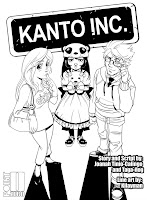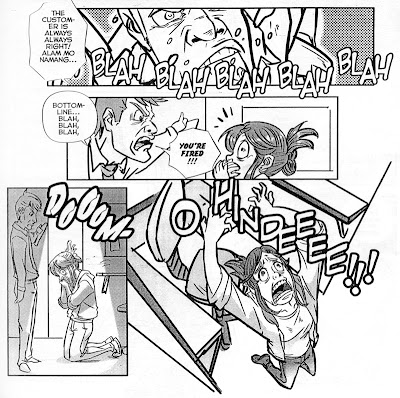Japanese comics and animation have a long and convoluted history in the Philippines. While anime has more or less been a constant presence on network television since the 1970s, manga has taken longer to establish itself. The reason becomes more apparent when walking into any well-stocked book or comic book store. All of the manga being sold are English-language translations from American, and occasionally Singaporean, publishers. So Filipino readers are only going to read something like, oh say, Emma because a CMX published it. This is in contrast to most televised anime, which are usually dubbed in Tagalog.* Filipino fans are largely dependent on foreign publishers for legitimately licensed manga. So a truly hardcore, self-consciously geeky, mangacentric, otaku subculture would only emerge after the widespread dissemination of such printed material to the local population.
I was barely around to witness the birth of Filipino otakudom. But it's no surprise that just as with western otaku, it wouldn't be long before a generation of fans would try their hand at producing manga-inspired comics. By all accounts, the high-water mark for Filipinized manga was the emergence of Culture Crash in 1999. Founded by James Palabay and Elmer Damaso, it was a comics anthology-type magazine featuring Filipino talent. At a time when all the old-style komiks publishers had vanished or were inactive, Culture Crash and a few other start-ups presented a brief opportunity to revive the industry. The magazine boasted professional-quality production values and art, drawn mostly in the "manga style". It published 14 issues before running out of money and closing up shop in 2004. Its creative staff have since moved on to other projects.
One of the former Culture Crash creators is Melvin Calingo (aka Taga-Ilog), who continues to self-publish his own comics. He and wife Joanah Tinio-Calingo launched a new series at Komikon 2010 called Kanto Inc. However neither of them is illustrating it. Art duties have been handed to Kilayman, who I'm unfamiliar with. This decision might have been made to suit the lighter tone of the story. Kilayman is extremely adept at rendering comical facial expressions. He's so good I wish sometimes that he cut down a bit on the intimate face-pulling in order to establish the setting more clearly. But he's clearly got a good handle on drawing fundamentals, and unlike other artists he isn't trying to cover-up any glaring technical weaknesses. His gift for caricature makes him quite capable of delineating the appearances and personalities of the characters.
The story in itself serves a local twist on your usual shonen-style cohabitation brought upon by odd circumstances. Guinevere Garcia is a recent college graduate who, like a lot of young Filipinos, is forced by limited options to work at a call center. However she's fired from her job after being unable to deal with a client who keeps insisting that his computer is under the control of a dwende. Fortunately, she's soon offered another job by an eccentric and very wealthy foreigner. He's looking for a live-in computer instructor to tutor him. However, his creepy lolita daughter may posses supernatural powers, and may have been partially responsible for getting her fired from her previous job. Despite these reservations, Guinevere is leaning towards taking the job, especially after learning about the various perks. It's obviously just the beginning for a longer tale. While not the wackiest idea put out, the premise sounds like it might be a solid enough foundation to attract younger manga fans.
If there is one criticism that can be leveled against the comic book, it's that the aschan format's print quality is inevitably ill-suited to reproducing the artwork, which relies on many gradations and zip tones. That's standard operating procedure for a lot of contemporary manga. But the laser printer/photocopy paper look muddies a few of the visuals. If Kanto Inc. manages to gain an audience, the comic would be better served in the future by superior reproduction in a trade paperback reprint.
___
* Of course the really hardcore fans are either going to purchase the American-produced DVDs, or acquire the anime through more illegal means.


